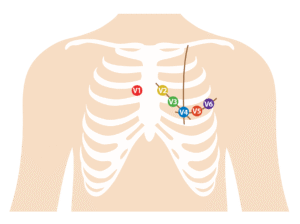Clinicians use electrocardiograms, commonly referred to as ECG or EKG, to assess the heart’s electrical activity and guide accurate ECG placement. The term “ECG” comes from English, while “EKG” uses the original German spelling “Elektrokardiogramm.” Both terms mean the same test, and clinicians use them interchangeably.
Accurate ECG placement is key to capturing signals that help with diagnosis and treatment. Clinicians apply ECG electrodes, also known as ECG stickers, to the skin to detect these signals. In this guide, you’ll learn how to place ECG electrodes step-by-step. You’ll also get tips for better accuracy and see which mistakes to avoid.
Understanding the Basics
ECG tests record the heart’s electrical impulses, allowing clinicians to monitor rhythm, detect abnormalities, and evaluate overall cardiac function. Clinicians use these tests during routine checkups, in emergencies, and for long-term monitoring with telemetry.
ECG Lead Systems Explained
Hospitals and clinics most commonly use the 12-lead ECG configuration. It provides a comprehensive view of the heart’s electrical activity from multiple angles. Other systems include the 3-lead and 5-lead setups, often used in telemetry or portable monitoring devices for continuous observation.
12-Lead ECG Placement: Step-by-Step
Precordial Leads (V1–V6):

V1: 4th intercostal space,right side of the sternum
V2: 4th intercostal space, left side of the sternum
V3: Midway between V2 and V4
V4: 5th intercostal space, midclavicular line
V5: Midway between placement of V4 and V5
V6: Horizontal to V4, midaxillary line
Limb Leads (RA, LA, RL, LL):
RA (Right Arm): Right forearm or wrist
LA (Left Arm): Left forearm or wrist
RL (Right Leg): Anywhere on the right lower limb (used as ground)
LL (Left Leg): Anywhere on the left lower limb
Download our printable 12-Lead ECG placement guide.
Tips for Skin Prep and Accurate ECG Placement
Clean and dry the skin before applying electrodes.
Each electrode side should be prepped by giving a dry rub to each site with a gauze pad to help remove dead skin cells, which in turn reduces the resistance of the skin.
Avoid placing electrodes on bony areas or within skin folds
Use hypoallergenic electrodes for patients with sensitive or fragile skin. Learn more about hypoallergenic options
Secure wires to reduce movement and minimize artifacts
- For a demonstration, watch this video on skin prep for ECG placement
Common Mistakes to Avoid
Swapping limb leads (RA with LA or RL with LL)
Placing precordial leads too high or too low
Skipping proper skin preparation
Using electrodes with poor adhesion or allowing them to loosen
Proper ECG electrode placement is critical for generating accurate readings that inform clinical decisions. Follow each step carefully. Prepare the skin well and choose electrodes that fit the patient’s needs. For more guidance on selecting electrodes based on application type, visit this resource.
For easy reference, download our printable electrode placement chart [link coming soon]. You can also share this guide with your clinical team to support training and consistency.
Browse our full line of ECG electrodes and accessories at hs.nisshamedical.com.
ABOUT THE AUTHOR

